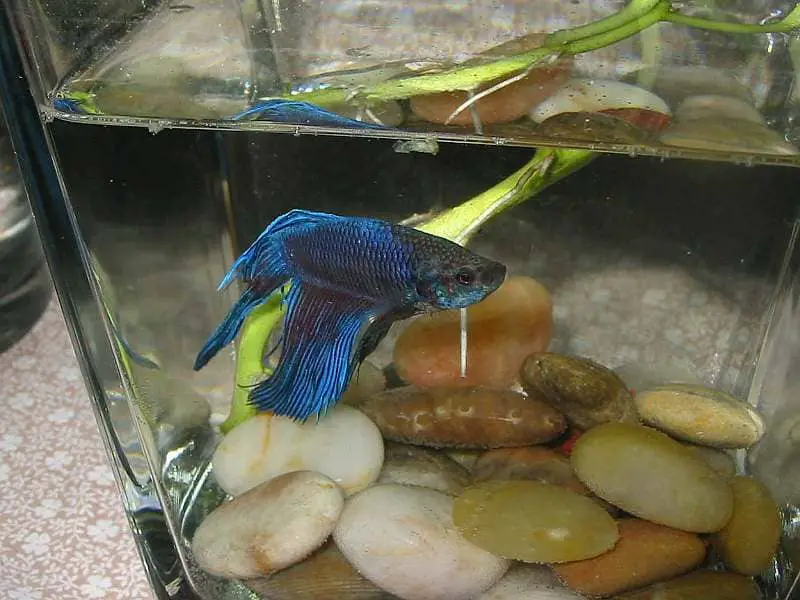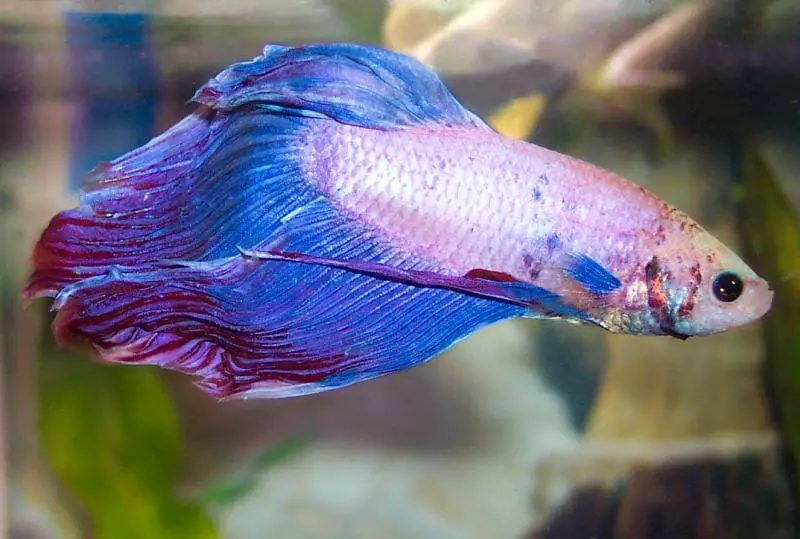Keeping a clean and well-maintained environment for your Betta fish is essential for their health and well-being. Betta fish, also known as Siamese fighting fish, are known for their vibrant colors and long, flowing fins. They make popular and captivating pets for both beginner and experienced aquarium enthusiasts. However, to ensure your Betta fish thrive and remain happy, it’s crucial to understand how often you should clean their tank.
In this comprehensive guide, we’ll explore the factors that influence the cleaning frequency of your Betta fish tank, the steps to properly clean it, and the signs that indicate when it’s time for maintenance. Whether you’re new to Betta fish care or looking to improve your current tank cleaning routine, this article will provide you with valuable insights to ensure your Betta’s habitat remains clean, safe, and enjoyable.

Understanding Betta Fish Tank Cleaning Frequency
Maintaining the cleanliness of your Betta fish tank is crucial for the well-being of your aquatic friend. The frequency at which you should clean your Betta fish tank depends on several factors that you need to consider. Let’s delve into these factors to gain a better understanding of how often you should perform tank maintenance.
Tank Size and Water Volume
The size of your Betta fish tank plays a significant role in determining the cleaning frequency. Smaller tanks require more frequent cleaning than larger ones because the water volume is limited, making it easier for waste and toxins to accumulate.
- Small Tanks (1-5 Gallons): If your Betta is in a small tank, you should be prepared for more frequent cleaning. These tanks can become polluted quickly due to their limited water volume. A small tank may need partial water changes of 20-30% every 1-2 weeks.
- Medium Tanks (5-10 Gallons): Tanks in this size range strike a balance between ease of maintenance and providing a suitable habitat for your Betta. Partial water changes of 20-30% every 2-3 weeks should suffice.
- Large Tanks (10+ Gallons): Larger tanks are more stable environments and require less frequent cleaning. You can typically perform partial water changes of 20-30% every 3-4 weeks in these setups.
Filtration System
The type and efficiency of your tank’s filtration system play a vital role in determining cleaning frequency. Filters help remove debris, excess food, and waste, maintaining water quality.
- Strong Filtration: Tanks equipped with efficient filtration systems can go longer between cleanings. In such tanks, you may only need to change 20-30% of the water every 3-4 weeks.
- Weak or No Filtration: If your tank lacks a filtration system or has a weak one, you’ll need to perform more frequent water changes. Small, unfiltered tanks may require partial water changes of 20-30% every 1-2 weeks.
Number of Fish
The number of Betta fish in your tank can impact cleaning frequency. More fish mean more waste production, which can lead to faster water deterioration.
- Single Betta: If you have just one Betta in your tank, you can maintain a stable environment with less frequent water changes. The guidelines mentioned earlier should apply.
- Multiple Bettas: In a tank with multiple Bettas, you may need to increase the frequency of water changes. Monitor water parameters and adjust your cleaning schedule as needed.
Presence of Live Plants
Live plants in your Betta fish tank can influence cleaning frequency. They help absorb nitrates and provide oxygen, contributing to a healthier environment.
- Planted Tanks: Tanks with live plants may require less frequent water changes, typically following the guidelines for medium or large tanks, depending on the number of plants and their growth rate.
- Non-Planted Tanks: Tanks without live plants may need more frequent cleaning, as there are fewer natural mechanisms to remove nitrates. Partial water changes every 2-3 weeks are advisable.
Water Testing
Regular water testing is essential to determine when it’s time to clean your Betta fish tank. Test kits are available to check parameters such as ammonia, nitrites, and nitrates. Monitoring these levels helps you maintain optimal water quality.
- Ammonia and Nitrites: If you detect ammonia or nitrites in the water, it’s a sign that your tank’s beneficial bacteria may not be keeping up with waste production. In such cases, perform a water change immediately.
- Nitrates: Nitrates are less toxic than ammonia and nitrites, but high levels can still stress your Betta. Perform water changes when nitrates reach 20-40 ppm, depending on your tank size.

Steps to Properly Clean Your Betta Fish Tank
Now that you understand the factors that influence cleaning frequency, let’s go through the steps for properly cleaning your Betta fish tank.
Step 1: Gather Your Supplies
Before you start cleaning, gather all the necessary supplies:
- A siphon or gravel vacuum
- Buckets for old and new water
- Water conditioner
- A clean, soft cloth or sponge
- Algae scraper or pad (if needed)
- A net
- Aquarium-safe cleaning tools
Step 2: Prepare Replacement Water
Fill a clean bucket with tap water. Use a water conditioner to remove chlorine and other harmful chemicals. Ensure the replacement water is approximately the same temperature as the tank water.
Step 3: Turn off Equipment
Before you begin, turn off any equipment in your tank, such as heaters and filters.
Step 4: Remove and Clean Decorations
Carefully remove any decorations, plants, or ornaments from the tank. Gently scrub them with a clean, soft cloth or sponge to remove algae and debris.
Step 5: Vacuum the Gravel
Use a siphon or gravel vacuum to clean the substrate. Start at one end of the tank and work your way across the bottom. The vacuum will remove debris and waste without disturbing the substrate too much.
Step 6: Partial Water Change
Use the siphon to remove 20-30% of the tank’s water. Slowly pour the replacement water into the tank. Be gentle to avoid stressing your Betta fish.
Step 7: Clean the Glass
If you have algae buildup on the tank walls, use an algae scraper or pad to gently clean the glass. Avoid using harsh chemicals or abrasive tools that could harm your Betta.
Step 8: Replace Decorations
Once the tank is clean and the replacement water is added, return decorations and ornaments to their original positions.
Step 9: Check and Restart Equipment
Double-check that all equipment is functioning properly, including the filter and heater. If everything is in order, you can restart them.
Step 10: Monitor Your Betta
Observe your Betta to ensure they are not stressed by the cleaning process. It’s normal for them to be a little wary at first, but they should adjust quickly to their clean environment.

Signs It’s Time for Tank Maintenance
In addition to following a regular cleaning schedule, it’s essential to be attentive to your Betta fish and monitor their tank for signs that maintenance is needed. Here are some key indicators that it’s time to clean your Betta fish tank:
- Cloudy Water: If the water in your tank appears cloudy, it’s a sign of high bacterial activity or excess waste. Perform a water change to restore clarity.
- Algae Growth: Algae can accumulate on the tank walls, decorations, and substrate. Excessive algae growth not only looks unsightly but can also affect water quality. Regular cleaning and maintenance can prevent this issue.
- Foul Odor: A strong, unpleasant odor emanating from your tank is a clear indication that something is amiss. It could be due to decomposing organic matter or poor water quality. In such cases, perform a water change and clean the tank promptly.
- Stressed or Unhealthy Betta: If your Betta fish exhibits signs of stress or poor health, such as loss of appetite, clamped fins, or unusual behavior, it may be related to water quality issues. Consider performing a water test and adjusting your cleaning schedule accordingly.
- High Ammonia, Nitrite, or Nitrate Levels: Regular water testing is essential to monitor the levels of ammonia, nitrites, and nitrates in your tank. If any of these parameters are out of the safe range, take immediate action to improve water quality.
- Dying or Dead Plants: Live plants can be a good indicator of water quality. If they are wilting, browning, or dying, it may be due to inadequate care or poor water conditions. Address the issue by adjusting your maintenance routine.
- Excess Food and Debris: Uneaten food and debris can accumulate at the bottom of the tank, leading to water quality problems. Ensure that you’re not overfeeding your Betta and remove any uneaten food promptly.
By paying attention to these signs, you can address tank maintenance issues promptly and provide a healthy environment for your Betta fish.
Conclusion
Maintaining the cleanliness of your Betta fish tank is a fundamental aspect of responsible fish ownership. The frequency at which you should clean your tank depends on factors such as tank size, filtration, the number of fish, the presence of live plants, and water quality. By understanding these factors and following a regular cleaning schedule, you can ensure your Betta fish thrives in a clean and healthy environment.
Remember that each Betta is unique, and it’s essential to observe your fish and adjust your cleaning routine as needed. A clean and well-maintained tank not only benefits your Betta’s health but also provides a visually appealing and enjoyable aquatic habitat for you to appreciate and enjoy.
